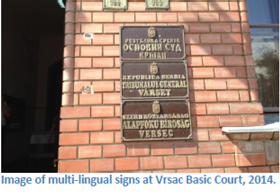Serbia Justice Functional Review
External Performance Assessment > Access to Justice Services
f. Geographic and Physical Access to Justice Service
i. Geographic Access to Court Locations
- Geographic barriers to access to justice are not a significant concern in Serbia, particularly in light of its manageable size and population. Around 73 percent of citizens and 85 percent of business representatives do not consider distance to the courthouse to be a problem. The elderly and the least educated are the only cohorts to indicate in a sizeable minority that the distance to the courthouse makes the judiciary less accessible.
- Average distance to a courthouse has reduced even further due to changes to the court network, effective 1 January 2014. An earlier UNDP survey found that the 2010 re-networking had somewhat hindered access to courts for some parts of the population, increased costs for the parties and their lawyers, and adversely affected lawyers working in smaller communities.584 However, the recent expansion increased the number of Basic Courts to 66 from 34. The expansion of courts was largely achieved by converting ‘Court Units’ to ‘Basic Courts’, thus almost doubling the number of Basic Court locations that hear criminal proceedings and hold hearings on a daily basis.
- Further expansion of the court network would be unnecessary. Future efforts to improve physical access to justice services would be best addressed using online strategies, such as e-filing. As internet penetration improves, geographic distance will become less relevant than before. The development of streamlined online processes can bring a range of court services directly to the user.
ii. Physical Layout of Court Locations
 The layout of courts is generally accessible for court users. Notwithstanding suboptimal physical
conditions, in both the 2009 and 2013 Multi-Stakeholder
Justice Surveys, respondents mentioned they did not
generally cite physical access as a barrier to the delivery of
court services. This suggests that access to justice efforts
should focus on substantive access to services. Nonetheless,
infrastructure upgrades have the potential to improve public
perceptions of access to justice by signaling a modernization
in justice service delivery and easing constraints for those
who work within courts.585
The layout of courts is generally accessible for court users. Notwithstanding suboptimal physical
conditions, in both the 2009 and 2013 Multi-Stakeholder
Justice Surveys, respondents mentioned they did not
generally cite physical access as a barrier to the delivery of
court services. This suggests that access to justice efforts
should focus on substantive access to services. Nonetheless,
infrastructure upgrades have the potential to improve public
perceptions of access to justice by signaling a modernization
in justice service delivery and easing constraints for those
who work within courts.585
- Persons with disabilities experience particular challenges in accessing courthouses. Respondents to the UNDP survey586 indicated that physical inaccessibility of judicial facilities is a primary barrier to access to justice for this group. Their concerns relate to the primary entrance to buildings, movement throughout facilities, and adaptability of information for those with visual, audio or learning disabilities.
- Further, in a few locations, navigation within courthouses can be challenging as signage is limited and the layout is not intuitive. In these locations, it is common for court users to roam the halls looking for courtrooms or counters. This puts disabled court users at a particular disadvantage, but also affects general court users. Increased use of clear navigation signs would be a low-cost initiative for these locations that would also save the time of court staff and likely increase user satisfaction. In areas where languages other than Serbian are common among court users, multi-lingual signs should be used. 587
 The layout of courts is generally accessible for court users. Notwithstanding suboptimal physical
conditions, in both the 2009 and 2013 Multi-Stakeholder
Justice Surveys, respondents mentioned they did not
generally cite physical access as a barrier to the delivery of
court services. This suggests that access to justice efforts
should focus on substantive access to services. Nonetheless,
infrastructure upgrades have the potential to improve public
perceptions of access to justice by signaling a modernization
in justice service delivery and easing constraints for those
who work within courts.585
The layout of courts is generally accessible for court users. Notwithstanding suboptimal physical
conditions, in both the 2009 and 2013 Multi-Stakeholder
Justice Surveys, respondents mentioned they did not
generally cite physical access as a barrier to the delivery of
court services. This suggests that access to justice efforts
should focus on substantive access to services. Nonetheless,
infrastructure upgrades have the potential to improve public
perceptions of access to justice by signaling a modernization
in justice service delivery and easing constraints for those
who work within courts.585